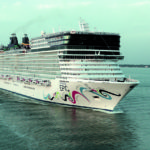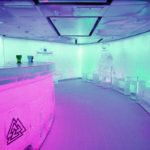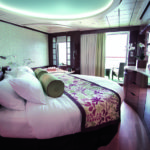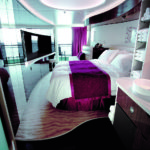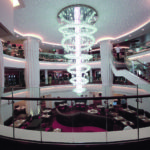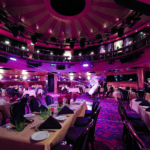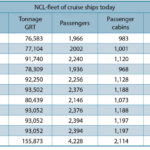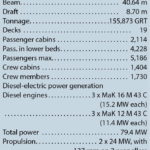Norwegian Cruise Line (NCL) and STX France signed a delivery agreement for the giant cruise ship »Norwegian Epic« (official measurement now 155,873 GRT) after long-lasting queries and discussions finally on June 17, 2010. The vessel represents the largest civil newbuilding the yard ever constructed in Saint-Nazaire. It is larger than cruise ship and North-Atlantic liner »Queen Mary 2« (145,693 GRT) delivered in 2003. »Norwegian Epic« is a fair-weather ship in a much lighter construction than rough-weather vessel »Queen Mary 2« with her stronger and therefore much heavier hull. Both cruise ships are much different in construction but also in life-style and comfort on board.
»The new vessel represents the next level of ›Freestyle Cruising‹ with branded entertainment, more than 20 dining options and a[ds_preview] wide range of accommodations including the largest suite complex at sea«, praised Kevin Sheehan, NCL’s Chief Executive Office (CEO). »Following more than four years of development and construction, we are pleased to take ownership of this large and inspiring ship and offer it to the world. We are confident that ›Norwegian Epic‹ will amaze our guests.«
Troubled shipyard
Construction of the vessel at STX France’s Saint-Nazaire shipyard (former Aker Yards France, ex Chantiers d’Atlantique) turned out to be an »epic task«. The vessel left Saint-Nazaire on June 17 after a final breathtaking race against time as the shipyard personnel and subcontractors struggled to repair the damage caused by a series of suspected arson attacks aboard the nearly completed vessel. Three fires had happened since the beginning of June until delivery.
The original contract from NCL, which was signed with Aker Yards France in September 2006, was for two ships plus one option for a total price of € 1.47 billion. At that time the yard still had not overcome management problems after Aker Yards had bought the majority of the facility in the beginning of 2006. The newly-formed department »Cruise & Ferry« was mainly managed by Finns, when it came to design, construction and even contracting, with all the national mentality problems between Scandinavians and Frenchmen. This was overshadowed again by new management ideas created by the new STX-owners from South-Korea who overtook Aker Yards in autumn 2008.
Queries with NCL contracts were not new for the Finns of Aker Yards, today STX Europe. Terror attacks to the USA on September 11, 2001, stopped all cruise ship contracting around the globe for almost two years. Various shipyards had to change their production schedules or even came into troubles. German Meyer Werft had very good relationships with NCL and mother-company Star Cruises as they both had ordered cruise ships there.
In the end of 2003, NCL started contracting again and wanted to receive four vessels at that time in the near future and before 2006. Meyer could not meet these requirements and accepted only two orders. NCL tried to place the contracts for the remaining two ships in Finland. But when Aker Yards Finland could book further tonnage from RCCL they realised that this would need all their capacity in design, construction and even in building and outfitting. NCL’s ideas were too different from all these possibilities Aker Yards Finland could offer. In April 2005, the still existing letter of intent was cancelled and NCL ordered two further cruise ships of the »Super-Panama-Max-Class« with Meyer.
Late in 2007, US-American investment group Apollo Management bought 50 % of NCL. This allowed NCL to think of future investments in newbuildings or upgrading of their ships in service. But youngest problems between NCL and STX Yards, former Aker Yards, occurred in September 2008, when construction of the first vessel was already under way. STX Europe admitted that it was in dispute with NCL, apparently over the costs of design modifications introduced in the course of construction by the cruise company.
Event today the causes of this dispute are still unclear. After negotiations lasting several months both parties came to an agreement in December 2008. This resulted in the cancellation of the second of the two vessels, but construction of the one already under way was to be finished.
Execution of the revised contract appeared to proceed smoothly during 2009, but new problems appeared early this year, that look likely to pose problems for STX rather than NCL. In March, STX Europe announced that it had incurred cost overruns of € 15–20 million on the contract although it assured that these would be met without difficulty from working capital.
Later the same month, one of the vessel’s six diesel engines suffered serious damage in the course of operation during first sea-trials and had to be replaced. Usually NCL uses MAN medium-speed four-stroke engines on board of their newly built vessels. This time Caterpillar’s MaK marine diesel engines were installed. Caterpillar normally offers impressive financing aids when their engines are installed. This offer is usully given to the operator, in this case NCL. Fortunately, a spare engine was available, otherwise the consequences would have been much more serious. The second series of sea-trials, which had been scheduled for April, had to be postponed one month to allow additional time for the work to be carried out.
But an extensive marketing campaign had already been started fixing mid-June as the delivery date. Final sea-trials began on June 10 preceding the vessel’s scheduled departure from Saint-Nazaire on June 17. The vessel was delivered on time to sail to Rotterdam for its first public presentation and the start of a two-day inaugural cruise to Southampton. Due to technical problems, which in no way affected the safety of the ship, »Norwegian Epic« arrived late in Southampton on June 22. It was said that there were some propeller-shaft problems, which NCL claimed they could overcome in Southampton. The vessel was due to leave Southampton on June 24 for its first transatlantic crossing to New York, where it was to be officially named on July 2. The ship indeed arrived there on July 1 but had to bring to water half the rescue-boats on starboard side before being able to land at the terminal of dock 88 in the port of New York. All rescue-boats are hanging free from the hull and not in recesses as it is usually the case.
So, when »Norwegian Epic« had left the yard it was realised that the yard was without any further important cruise ship contract to work on. Italian / Swiss Mediterranean Shipping Company (MSC) had signed a letter of intent early in March this year, after delivery of another Super-Panamax-cruise-ship of »Musica« class. But it took time to pull the financing through. On July 23, 2010, it was confirmed that another »Fantasia« class vessel (133,500 GRT) should be built until the end of spring 2012.
On June 30, 2010, astonishingly enough, another cruise-ship contract was landed from an completely unknown operator:Libyan State owned company GNMTC. They ordered the first cruise ship, a super-sized cruise ship of 139,400 GRT; 333 m long and 38 m wide; with 1,739 passenger cabins and 732 crew cabins. Delivery of this giant ship is scheduled for December 2012. So, STX Europe seems to be well of in France, at least until of 2012.
Reception in the USA
But back to »Norwegian Epic« which had left Europe by end of June. The culmination of the naming ceremony in New York came when ship’s godmother, country music icon Reba McEntire, appeared on stage on board »Norwegian Epic« to push a digital Champagne bottle on the big movie screen in the »Epic Theatre«, triggering a seconds-long video of a Champagne bottle smashing against the ship’s hull, and signifying the official debut of the new cruise ship. For a maritime traditionalist there may be allowed the question, what the ship’s kobold thinks about this more or less electronic christening of a ship.
Besides various guests also on hand were NCL executives, including CEO Kevin Sheehan, member of NCL part-owner Apollo Management, and upper management from STX Europe. While the ceremony was overwhelmingly upbeat – basically a highlight of Epic’s innovative entertainment – Sheehan took a moment to reflect on the difficult road »Norwegian Epic« had navigated from initial concept to launch.
»We faced lots of challenges, but we rose to the occasion«, Kevin Sheehan confessed quite openly. »It has been a hard slog for NCL from the early beginning, when contractual disputes between the company and the shipyard resulted in the cancellation of the originally planned second Epic-class newbuilding plus option, as well as some heavy fines for NCL to pay (€ 100 million for the cancellation; € 55 million for design changes)«.
»There may still be some kinks to work out, especially the ship’s controversial ›New Wave‹ cabins. They have semi-transparent doors for the separated toilet as well as the shower areas. Only a curtain divides these parts of the cabins from the rest of it, and a shallow sink that tends to splash water in all directions. These wet departments are positioned just by the entrance, so one has to walk through them to reach the cabin’s living area«.
Christening of »Norwegian Epic« on July 1 was followed by a two-day inaugural cruise. The newbuilding was also host venue for the 34th Annual Macy’s 4th of July Fireworks. This event included a national one-hour live entertainment broadcast on NBC-TV that began early in the morning. The ship arrived in Miami on July 7, where a welcome event was held at Bicentennial Park in the early afternoon.
Following all these inaugural activities, »Norwegian Epic« started sailing alternating seven-day Eastern and Western Caribbean itineraries from Miami beginning from July 10 through April 30, 2011. Ports of call on the Eastern Caribbean itinerary include Philipsburg, St. Maarten; St. Thomas, US Virgin Islands; and Nassau, Bahamas. The Western Caribbean cruises visit Costa Maya, Mexico; Roatán, Bay Islands, Honduras; and Cozumel, Mexico. The 2011 cruise season from May to October will have the vessel sailing a series of seven-day Western Mediterranean cruises from Barcelona. When she returns to Miami on November 5, 2011, she will sail a series of seven-day Eastern Caribbean cruises through April 7, 2012.
About Norwegian Cruise Line (NCL)
NCL counts itself as the innovator in cruise travel with a 44-year history of breaking the boundaries of traditional cruising, most notably with the introduction of »Freestyle Cruising« which has revolutionized the industry by allowing guests more freedom and flexibility on board.
NCL, the originator of contemporary cruising, was founded in 1966 by three Norwegian shipping companies, of which Klosters Rederi A/S was the leading one, as Norwegian Caribbean Line. They joined Miami businessman Ted Arison in marketing Caribbean cruises from Miami. In 1972 Ted Arison founded his own company Carnival Cruise Lines, which is with daughter-companies the largest cruise operator world-wide by far today.
Later in the 1980s Klosters started to create the giant »Phoenix« project (see HANSA 9/2008, page 38; ~250,000 GRT; 5,200 pass.; 1,850 crew members) but never got it financed. In summer 1979, NCL purchased the well-known Atlantic-Liner »France« and converted her at German Lloyd-Werft in Bremerhaven to cruise ship »Norway«. This traditional Atlantic-Liner became the flagship of the NCL-fleet and guarantied the commercial success of the company for years.
In 1996, after the reunification of Germany and the privatisation of Deutsche Seereederei in Rostock (DSR) by shipping managers Horst Rahe and Nikolaus Schues, the idea of a complete new lifestyle on board a cruise ship, the »Clubschiff«, was born and put into service with the first newbuilding of this new type, the »AIDA«. But it became difficult to introduce this new idea to the market. It went not fast enough for a good repayment rate of this investment. Only a year after introduction, »AIDA« had to be sold and re-chartered. NCL became the lucky new partner. They provided the money, so they were able to study the new idea of the »Clubshiff« directly.
When NCL was bought by Star Cruises in 2000 and new money for investments came in, NCL started the replacement of its older, smaller ships with brand-new, larger vessels, mainly newly built or converted by German Meyer Werft as well as Lloyd Werft in Bremerhaven. NCL started also to run the all-American company NCL America with the exclusive right to operate between the Hawaiian Islands.
From the »AIDA«-experience with its colourful decorated hull (»Hot Lips«), its free-style dining and wining as well as its entertainment, NCL created their as innovative declared idea of »Freestyle Cruising«. Today all ten cruise ships and this one in addition follow this economical cruise experience.
»Freestyle Cruising«
The introduction of »Freestyle Cruising« changed everything for NCL since 2000. By banning set schedules and predetermined dinner times, not to mention formal dress codes, complicated disembarkations and rigid accommodations, NCL completely revolutionized the cruise industry. There has been only one forerunner, AIDA Cruises, which introduced their »Clubschiff« in 1996. Today, they run seven ships with two further ones on order. The »Clubschiff« influenced also the design of two »Ocean Village« vessels of former mother-company P&O Cruises in 2002. One year later the Carnival Corporation and P&O Princess Cruises merged to become the world’s largest cruise company, with more than 60 ships and 13 brands. In the end of this year »Ocean Village I + II« will be transferred to P&O Australia and the European trademark of Ocean Village will be scrapped.
With the delivery of »Norwegian Epic«, NCL is proud to announce: Now we are about to do it again. The next level of »Freestyle Cruising« exists and the cruise industry will never be the same. Whether this is or will be true, the passengers will confirm by their future bookings.
NCL is still marketing: When you are »Freestyle Cruising« aboard »Norwegian Epic« your schedule is the only schedule we insist you keep. And boredom is the only option we refuse to offer.
»Norwegian Epic« can offer superlatives when it comes to Freestyle Dining: 14 restaurants and six further dining options offer culinary delicacies from Asia to America, from Italy to France, from à la carte to NCL’s unique buffet with show cooking. And in their new »Spiegel Tent«, one can enjoy an impressive entertainment dinner with acrobats, aerialists and musicians.
No less than 20 bars and lounges promise the right Freestyle Nightlife for everyone, also after the sun goes down. Whether in the first true ice bar at sea, in the »Bliss Ultra Lounge« nightclub, in the new comedy and blues clubs, in the open air beach clubs or in the theatre with unique shows on the high seas – diversity and impressive cruise-pleasure guarantied.
»Norwegian Epic« sets new standards in terms of onboard Freestyle Experiences entertainment with a one-of-a-kind »Aqua Park«, the first tube slide at sea and the expanded sports deck with climbing garden and the new spider web. And in the »Posh Beach Club«, suites and villas guests can look forward to Mediterranean flair combined with the sizzle of South Beach and the Riviera.
Finally Freestyle Living is presented in the innovative »Wave Staterooms«, completely fresh with curved lines and walls, an open living concept and thus even more space in one’s home at sea. Contrary to this, new »Studios« are just as impressive with access to the new private »Living Room«. And on top of the top (Deck 16 and 17), luxury rules around the largest »NCL Courtyard« area – for the first time featuring a private restaurant and club lounge. This is really something new in all respects.
Technical details
The newbuilding is not the longest and not the widest vessel in the world, but most probably one of the most compact ones counting the space given to a passenger (GRT/pass.). Also the L x B x D indicates a quite high displacement. The final official tonnage measurement declared »Norwegian Epic« with 155,873 GRT to the second largest cruise ship in the world for the time being. Only »Oasis of the Seas« (225,282 GRT) is bigger and »Independence of the Seas« (154,407 GRT) is just smaller, but still positioned before »Queen Mary 2« (148,258 GRT), which was also built in Saint-Nazaire.
From keel to top, »Norwegian Epic« counts 19 decks (including Deck 13), of which 15 are open to the public. The remaining four decks and half of Deck 5 are technical rooms or accommodation for the crew. Half Deck 5, full Decks 6, 7, 15, 16 and superstructure islands on level 16, 17 and to a really minor extend Deck 19 are the public decks for entertaining and wining as well as dining for the passengers. All other decks are filled with passenger cabins and other sorts of accommodation facilities and their accompanying rooms and places for the provision of the cabins.
Public rooms
Normally passengers enter the ship on Deck 5, portside, into the »Atrium« with a long Reception Desk as well as places to sit and wait until to be guided to the booked cabin. During the voyage this room is also used as gathering point. Walking forward the two-levelled »Epic Theatre« can be reached near the bow. Strolling aft the »Taste Restaurant« for informal breakfast, lunch and even dinner is available or using the escalators up to Deck 6 the quite large »Epic Casino« is the right choice.
Going forward to the bow the around the clock opened Bistro »O’Sheahan« can be found with as all kind pub sports’ activities such as family bowling, Dart, Pool-Billiard, table-football, video- and other games. Further forward more sophisticated entertainments are on choice such as more than two decks high »Spiegel Tent – Cirque Dreams and Dinner« (275 seats) on portside and »Headliners Comedy Club« (The Second City) on starboard. At the »Entertainment Kiosk« one can look for tickets for the next show in the huge more than two decks high »Epic Theatre« (900 seats). The »Blue Man Group« is the main entertainer here.
A round vertical hole from over Deck 5 until the ceiling under Deck 8 widens the room aft the »Atrium« to the main vestibule and centre-point of the ship.
The main piece of art in this big hole in the structure of the vessel is a giant chandelier. It is the largest LED chandelier at sea installed in the ship’s »Epic Casino«, which was announced by NCL as the largest at sea. The chandelier, which can change colours to all in the spectrum – up to 255 possible variations – has a height of 6.40 m, a diameter of nearly 3.35 m and weighs two metric tons. It was built in Vienna, Austria, by Kalmar, a leading glass crystal maker who has designed some of the largest chandeliers for hotels around the world, and designed by UK-based SMC Architects and Lighting Design. It is fitted with approximately 40,000 crystal glass pieces of various shapes and sizes, and spans vertically to three decks, with vantage points from the casino, Teppanyaki restaurant, Wasabi Sushi Bar, Malting’s Whiskey Bar, Shaker’s Martini Bar and the Atrium.
The design is of spiralling oval discs, each up to 9.15 m in circumference, and 112 suspended crystal encrusted balls of up to 0.30 m in diameter, which orbit the main structure at varying heights. This chandelier alone is one of the most efficient at sea. It is completely illuminated by LED technology, using over 10,000 diodes. It is fully dimmable to most effectively enhance the lead crystals and is currently being programmed by UK-based Project International. The impressive structure, which is the focal point of the ship’s »Atrium«.
Walking from this chandelier aft on Deck 6, one passes by »Shanghai’s Chinese Restaurant«, the »Cascades Bar«, »The Fat Cats Blues & Jazz Club« and finally lands in »The Manhattan Room Dinner & Dancing« (590 seats). One level higher on Deck 7, the »Cagney’s Steakhouse & Churrascaria« is the famous restaurant, filled with Argentinean inspiration.
Strolling from here forward, one passes by some bars, Japanese food stations and restaurants, various shops, the upper level of »Spiegel Tent Cirque Dreams & Dinner« and reaches finally the »Bliss Ultra Lounge« besides the main bowling centre with three lanes. Deck 5–7 are the main promenade decks.
»Nordic Epic« is allowing smoking onboard to a great extend. Where is smoking liked very much? Stress brings a lot of persons into their own smoking compulsion and this is easily and very often the case in a gambling area or casino on board of the newbuilding the casino is centrally located on Deck 6 with more or less open promenades to the stairs fore and aft as well as to the three decks high »Atrium« with its wonderful crystal chandelier. Already during the press-trip from Rotterdam, numerous journalists were worried about the density of cigarettes and cigars smoke creeping through these three main promenade decks.
It is not possible to walk all around the ship’s superstructure on one deck. But on Deck 7 there are jogging tracks on port- and starboard-side. It is exactly the area, where the rescue- and tender-boats are hanging out on both sides of the vessel. The boats are positioned completely free from the hull and are to be entered by the passengers via pedestals from Deck 7. So, in an emergency case Deck 7 is the place to gather and go under control to the named boat.
Passenger accommodation
Deck 8–14 and forepart of Deck 16 +17 are cabin-decks for the passengers. All together there are 2,114 cabins installed and counting in medium two persons in one cabin 4,228 passengers might be onboard on a normal cruise trip. The maximum capacity is 5,186 passengers. There are 1,404 cabins for all together 1,730 crew members in single- or more-bedded rooms. Most of the outside cabins have their own balcony. The main bulk of the passenger cabins are of a standard size of around 20 m², called »Stateroom«.
One of the big talking points about »Norwegian Epic« is their cabin architecture, especially for their »Staterooms«. Peoples having been onboard confirm that they all are very stylish, like in a »Design Hotel«, and look much better in real than they do in photographs. They have curved walls, what is very expensive and difficult to build. But indeed, this was mainly made to save space. Of course, it also helps to disguise the fact that all standard and deluxe balcony cabins are narrower than most cabins on other modern ships.
Controversially in the vast majority of the cabins, all do not have a conventional bathroom. They have the toilet and shower split into two compartments with a hand-washing place extra before them in the cabin. Both sanitary compartments are surrounded by frosted glass mounted in sliding doors. These compartments are positioned exactly left and right of the entrance door of the cabin. This design cleverly saves space and allows the creation of narrower cabins – hence more passengers. There is a vanity sink next to the sanitary compartments. The wet area, just around these three locations and by the cabin door, has a »wooden effect« floor, which tends to be slippery when being wet. The bed- / living-room area is covered with carpet.
As offered in »Freestyle Cruising« for »Freestyle Living« various choices for different accommodations are possible. Eight »Deluxe Owner’s Suites« (~79 m²; Deck 16 + 17) with room for up to four boast all around floor-to-ceiling windows. They include a separate bedroom with king-size bed, a living room, separate dining area and a private balcony with an amazing view. There is also a luxurious bathroom with separate shower and a whirlpool tub, additional bedding to accommodate two more guests and access to the Courtyard area, Concierge Lounge and private restaurant and bar. It also includes Butler and Concierge service.
This »Deluxe Owner’s Suite« (~79 m²; from ~600 € / night / person) is the highest grade of comfort and price one can book onboard »Norwegian Epic«. It is followed by the 52 »Courtyard Villas« (~47 m²), »Courtyard Penthouses« (~30 m²) and »Spa Suites & Penthouses« (~30 m²). Most of them are positioned on Deck 16 + 17 and have Butler and Concierge Service as well as access to the Courtyard area, Concierge Lounge, private restaurant and bar. Prices start from ~300 € / night / person depending on the destination and season.
»Mini Suites« (~23 m²) of different types are down-grading to »Balcony Staterooms« (~20 m²) as well as »Inside Staterooms« (12 m²). They are equipped with two lower beds, sitting corner, mainly with balcony, toilet, shower, hand-basin and wardrobes. All cabins are fitted with phone, TV, fridge, hair-dryer, safe, air-conditioning and various lightings, but no table. Prices are ~150–300 € / night / person. A new NCL-creation are the »Studios« (~9 m²) with an absolute minimum of the before mentioned equipment. Originally, they were planned for two persons, but today they are mainly sold to singles. As these cabins are rather small, two special »Studio Lounges«, connected by stairs, are offered to have more living space. These inside cabins cost ~80–150 € / night /person. They are the real cheap-makers.
But for comparing prices one needs to know what is included and what has to be paid in addition or extra. Basically food, soft-drinks, coffee or tea as well as entertainment around the day are included. Eating or dining in the main and buffet restaurants generally is included in the cabin-price. Alcoholic drinks in all restaurants, bars, lounges and during the shows have to be paid extra. Most of the speciality restaurants charge extra prices in addition. These extra charges can be 8–19 € / meal / person and generally a service-fee of 9 € / day / person is to be paid.
Fun-Park on Deck 15–19
The absolute top-hit on the top of the vessel is the three-storey high, 60 m long tube »Epic Plunge«. One drops from a platform on Deck 18, between the funnels and the climbing walls through the biggest bowl slide at sea, twisting, turning, thrilling and finally dropping down to Deck 15 to reach the vessel’s »Aqua Park«. One third of this deck is filled with food-stations more or less close the beach. The aft two thirds are mainly used to lie in the sun or to bath in swimming- or whirl-pools. At the real aft-end of this deck fashion and fun poolside shopping as well as »Spice H2O« Pool Bar & Grill can be found
On Deck 14 aft the »Mandara Spa«, »Pulse Fitness Centre« and special relax zones are arranged. Deck 16 sees the special »Courtyard Pool & Spa« surrounded by the ultra exclusive and ultra luxurious villa complex in the first fore-part of this deck. The second middle-part consists only of sun-deck galleries, going over into the aft third with »Hip Entourage Teen Lounge« and the upper part of »Spice H2O« pool bar and grill.
Deck 17 + 18 houses in the forepart the private courtyard complex and aft around the funnels the »Sports Complex« with tennis-, baseball-court, »Epic Plunge« and climbing walls.
Power generation
Caterpillar Marine Power Systems (CMPS) supplied the ship’s power plant comprising 3 x MaK 16 M 43 C and 3 x MaK 12 M 43 C marine engines. They have 430 mm bore, 610 mm stroke, 500–514 rpm, 900–1,000 kW/cylinder and 175–178 g/kWh specific fuel-oil consumption (more details see HANSA 12/2004, page 35 and lately 8/2009, page 41). Utilising a diesel-electric set up, the six long-stroke medium-speed engines provide a total of 79.8 MW (84 cylinders) for ship propulsion and onboard electricity supply. With MAN engines type 48/60, a version NCL were using before, they would have needed only 67 cylinders and with a Wärtsilä 46 engine all together 80 cylinders.
The ship is propelled by 2 x 24 MW propeller shaft-lines running on 137 rpm using five-bladed propellers outside and electric motors inside the hull. The outside shaft-lines are connected to the ship’s structure by two pairs of girders each. Two rudders are used in the propeller-streams to manoeuvre the vessel. Under slow speed manoeuvrability is optimized by transverse-thrusters at bow and stern.
Environmental protection is among NCL’s highest priorities for these newbuildings. A customer-specific engine rating address all areas of concern. The MaK M 43 C engines meet DNV Clean Design requirements reducing NOx emissions to 10.4 g/kWh. A lower cylinder rating decreases the specific fuel oil consumption and thus also CO2 emissions. Finally the proprietary Flexible Camshaft Technology (FCT) ensures that smoke at all operating conditions is well below visibility.
Besides STX Europe also Italian cruise-shipbuilder Fincantieri uses other MaK M 43 C engine versions for their various newbuilding projects such as for Holland America Line (HAL), Costa Crociere, Cunard and Carnival Cruise Line (CCL), all belonging to the Carnival Corporation. So, AIDA Cruises, also owned by Carnival, went the same way, building six »Clubschiffe« there, using 4 x MaK 9 M 43 C engines with total 36 MW.






